About this entry
You're currently reading "Land of the Giants" an entry on Kate Turkington
- Published:
- 09.07.16 / 11am
- Category:
- Travel
Land of the Giants
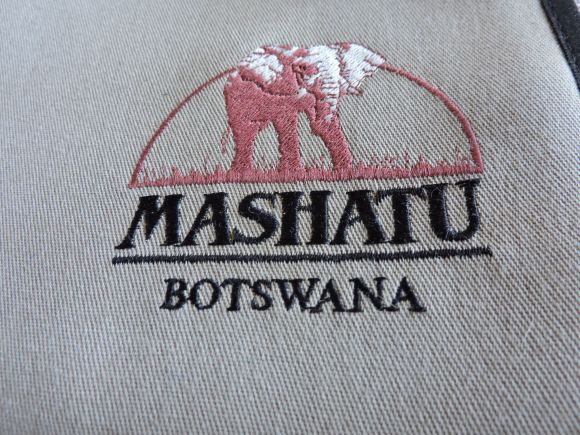
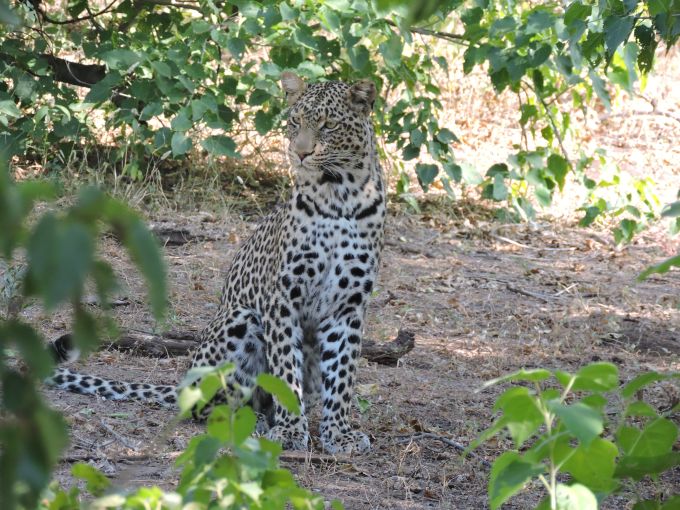
Female leopard resting while she hunts
Land of the Giants
This article was first published in City Press July 3 2016
“What’s the word for ‘wilderness’ in French?” I ask my two fellow passengers from Paris sharing our open game vehicle. We are driving around Mashatu Game Reserve, the 29 000ha of private wilderness in Botswana’s Tuli Block where the three countries of Botswana, Zimbabawe and South Africa meet. Martine and Jean-Jacques look blankly at each other. Finally they decide that there’s no such word in French. The only way they can describe this vast unpeopled untamed expanse of savannah, marshland, riverine forests, sweeping plains, sandstone outcrops is ‘La Nature Sauvage’ which means ‘savage nature’ in English and doesn’t really fit the bill at all.

The sun sets in the Land of the Giants
Easily accessible from South Africa by road (think six hours from Johannesburg or Pretoria) you’ll cross into Botswana over Kipling’s ‘grey, green, greasy Limpopo’. Although this year the mighty river is brown, dusty and dry and instead of the usual crossing in the tiny cable car, we drive across it in an open landcruiser.
Mashatu is called ‘The Land of the Giants’ not only because of its huge ancient trees including the locally-revered Mashatu tree and iconic baobab, but also its massive elephant herds, the largest in Africa on privately owned land. Throw in the world’s tallest mammal, the giraffe, the world’s heaviest flying bird, the Kori bustard, the world’s biggest antelope, the eland, and you’ll begin to understand why. And that’s even before you add in hundreds of other animals including lion, leopard, elephant, the charming bat-eared fox, charismatic honey badger and over 350 species of birds.
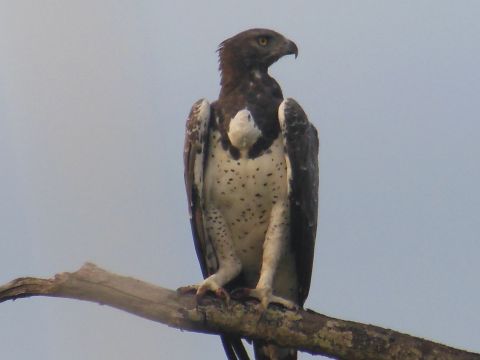
Martial eagle
But there’s even more to Mashatu than this ‘savage’ wilderness. It shares its territory with sister ruins of the ancient African kingdom of Mapungubwe, San/Bushman rock paintings and historic Anglo-Boer battle sites.
I’ve been visiting the area for over 30 years. This is where in the early 1980s Gareth Paterson, South Africa’s ‘lion man’ lived as a human member of a lion pride in the wild. His book Cry for the Lions became an international bestseller.
Another renowned South African filmmaker and photographer is currently doing research at Mashatu. Emmy award-winner Kim Wolhuter, whose legendary grandfather was Kruger National Park’s first game ranger, is working with a clan of spotted hyenas.
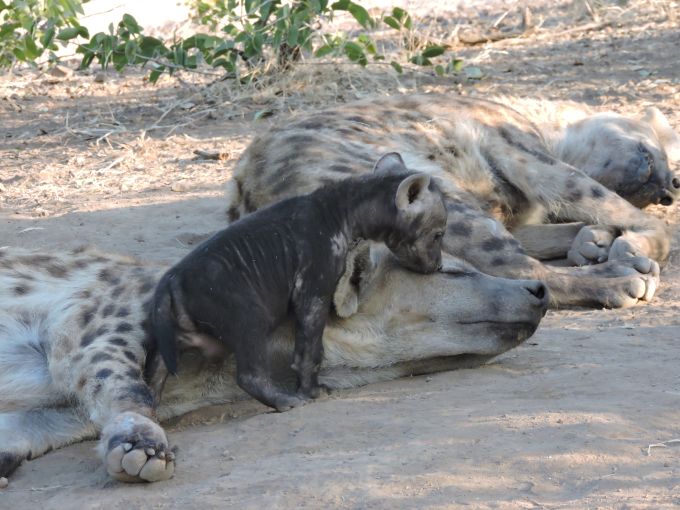
Hyena den
Mashatu is famous for its predators. You’d be very unlucky not to see leopards and lions, often with cheetahs thrown into the mix.
We bump along a dry riverbed, revving up sandy sloping banks, and braking down even steeper ones hoping for a leopard sighting. Dawn has broken, we’ve had a coffee stop, and now it’s mid-morning. On cue, a beautiful female leopard pads softly towards us through the croton trees.
Mashatu is famous for its predators. You’d be very unlucky not to see leopards and lions, often with cheetahs thrown into the mix.
She’s hungry and is prepared to catch anything – even a guinea fowl. She sits and waits. Crouches, leaps forward, and vanishes into the bushes. We didn’t find out if she got her late breakfast as the bush was too thick to follow her. That evening on another game drive, we find another female leopard on the hunt. These creatures are habituated to vehicles and being nocturnal animals, spotlights don’t bother them at all. It really is one of the great experiences of ‘savage nature’ to follow them as they weave and prowl through the African bush.

Waiting hopefully...
The next morning we encounter a breeding herd of elephants. Mashatu is famous for its elephant herds. In the eighties, when poaching was at its height, elephants from neighbouring Zimbabwe took refuge here. They were extremely aggressive and nervous and rarely a game drive took place without an elephant ‘incident’ of some kind or another. Today, they have learned to be unafraid, but Eric our ranger and his fellow rangers know that even though they can often drive right up to a herd, even if there are tiny babies, as Eric wisely says, “we are never complacent”.

Mother and tiny baby elephant in the nearly dry riverbed
We watch a huge bull elephant amazingly stand up on his hind legs to grab some succulent leaves of a scrotia tree. How he doesn’t topple over is a mystery. Outside the Discovery Room back at Mashatu Main Lodge an elephant growth line is carved into a dead tree trunk. A baby elephant starts off life at just under a meter. Fully grown it can reach up to three meters in height and weigh nearly five and a half thousand kilograms. And can stand on its two back legs…

A hungry elephant raids a croton tree
A highlight of this trip was finding an African rock python because I hadn’t seen one for years. Three meters of rippling autumnal colours of ochre, yellow, bronze and brown cross the sand road in front of our vehicle. The python then coiled itself up under a tree, black eyes gleaming and tongue flicking. ‘It’s looking for a place to hibernate for winter.” Eric tells us.
Another highlight was a visit to an underground hide where you can eyeball and photograph elephants and other animals and birds at safe close range. Get the help of one of the two resident Mashatu professional wildlife photographers, hire a mega lens if you want top-of-the-range wildlife photographs, or just sit as my friend and I did, and watch the passing show.
If you want to get active, bring your mountain bike and take a cycle safari, go on a walking safari, or a Limpopo horse safari.
Kids of all ages are welcome at Main Camp with special adventure programmes and a dedicated ranger, but have to be over 12 at the Tented Camp, which although very comfortable with ensuite safari tents and a pool, is unfenced and in a very remote and wild part of the reserve. (I love it there!)
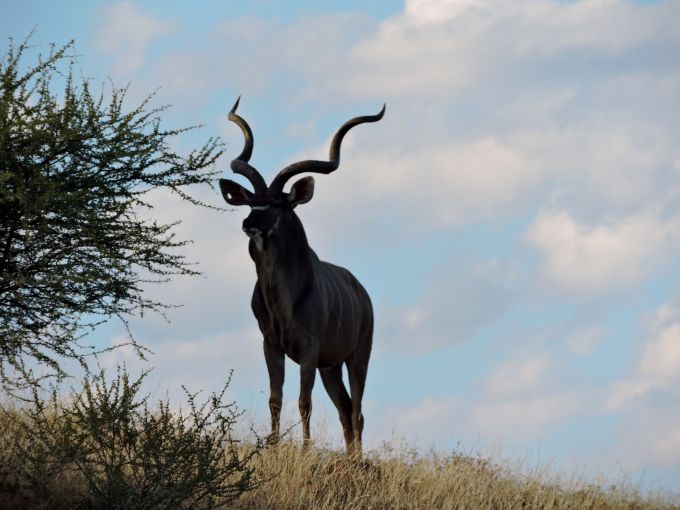
A fine kudu bull
The Mashatu staff is exceptional – friendly, wise, caring and professional with the majority from the Sebirwa district of eastern Botswana. Many have been here for well over ten years, including our ranger, Eric, who has 17 notched up in his belt. “After five years working here, you’re still a newcomer.” he jokes.
Visitors come here from all over the world including many from South Africa who return again and again.
When you visit you will see why.

The main deck overlooking a busy waterhole
Kate Turkington was hosted by Mashatu Game Reserve
www.mashatu.com